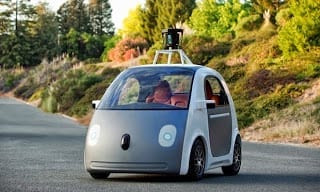Google moved to the next stage of its driverless car vision by unveiling a new self-driving car prototype. The new self-driving cars offers no steering wheels, brake pedal, or accelerator. It just features two seats for the passengers, a start button, and a large red button for stopping the car on emergencies.

The Future of Cars
Before now Google has been fitting other cars with its self-driving kit. First it was the Toyota Prius, then the Lexus SUV, now Google is building its driverless car from scratch.
The Google driverless cars are subcompact electric cars powered by an electric motor. It offers a range of about 100 miles (about 161 KM) with a speed limit of 25 miles per hour (about 40 KM per hour). The cars are designed more like taxis (at least for now). Intending passengers will summon the car using their smartphone specifying the pickup location and destination.
The car drives itself to your location. There are two seats with seat-belts for passengers and room for luggage. You press the start button in-between to two seats to start the car. That’s all you do. You just seat back for the ride. There is no steering, no brake pedals or accelerator. The cars however offers a display that shows you the current weather and speed.
While moving, the Google self-driving car uses a combination of GPS location, accurate digital maps, radars, lasers, cameras, and software to navigate the road. The cars can recognise objects and people as it moves along the road with a 360 degrees coverage and up to 600 feet (182 metres) in all directions. Google driverless cars can also recognise road signs and traffic lights and act appropriately according to traffic rules.
Google self-driving cars are not aimed at replacing your personal car, the vision is aimed at making owning a personal car irrelevant and probably saving parking spaces. In essence these Google cars will do for the auto industry what streaming music is doing to the music industry, but first the safety and regulatory issues will have to be overcome first.
However, Google is undeterred. They have built 100 prototypes for testing and says they will be road-ready by early next year.





